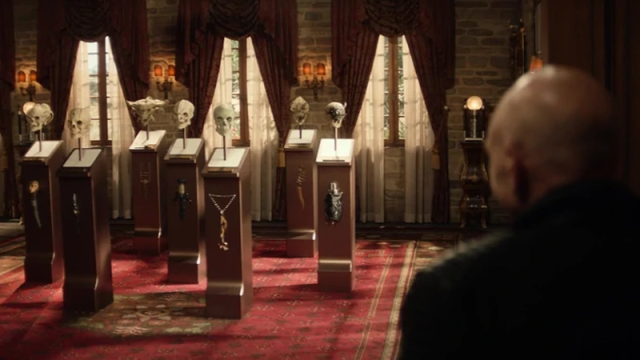Last week’s episode of Picard thrust its heroes into a dark reality where Jean-Luc was not an ideal hero of the utopian Federation, but a butchering general of an evil Confederacy. It asked many questions of the man, but it also asked us this: every wondered what was going on inside a Klingon’s head… quite literally?
Although Picard is given many hints that the world John de Lancie’s delightful cosmic arsehole Q has snapped him into in “Penance” is not a pleasant one, things become very clear for him and us early on in the episode when Q shows Picard a very gruesome trophy room. Lined with the picked-clean skulls of “General” Picard’s enemies, it’s a notable who-who of Star Trek alien figures… who in this timeline are just very, very dead.
Production designer David Blass has taken to Instagram to show off the display of skulls, each designed by concept designer Neville Page, and it’s a sight to see. There’s “cameos” of Trek faces like Ambassador Sarek (Spock’s dad), DS9‘s General Martok, Gul Dukat, and Grand Nagus Zek up close, and there’s some fascinating details to be found beyond the gruesomeness. There’s M’talas of the Lihn Zhee, a cheeky reference to Picard showrunner Terry Matalas, and even a Borg skull for good measure. But it might also just have you very curious about Star Trek xenobiology for a minute. Like… what’s up with the Ferengi’s big ol’ lobes having actual bones in them?
Ferengi ears are famously sensitive in Star Trek lore, with Ferengi seeing their oversized ears as erogenous zones — but considering that beyond that we’ve never had to think about Ferengi ears this much, it was perhaps surpising to some to see them represented in this grim anatomy lesson. But according to Blass, that’s just the kind of thing you think about when you need to come up with a room full of alien skulls. “Of course when it came to the Ferengi we discussed the Bone vs Cartilage in the ears,” Blass’ caption on Instagram reads in part. “Many species have Flexible Dermal Armour, Microdocodon gracilis had hyoid bones that were flexible and required for eating. Add to that humans having bones in the ear specifically designed to facilitate auditory functions. The Ferengi Ears warranted this type of discussion.”
The more you know! Click through to go up close and gruesomely personal with a few Star Trek icons’ inner workings. You know, if you’re into that sort of thing.
Wondering where our RSS feed went? You can pick the new up one here.
